27 Mar 2025
BlogOverview
Mastering building condition reports is essential for property managers. These documents provide critical assessments of a property’s state, identify maintenance needs, and ensure compliance with safety regulations. Effective use of these reports enhances asset value and tenant satisfaction, while also aiding in proactive management strategies. Such strategies are crucial for navigating the complexities of real estate in a competitive market. By prioritising these reports, property managers position themselves to not only meet regulatory requirements but also to elevate their operational effectiveness.
Introduction
In the realm of property management, building condition reports stand as indispensable tools that provide a comprehensive overview of a property’s health and safety. These reports not only identify existing issues but also play a crucial role in maintenance planning and regulatory compliance. As the landscape of property management evolves, understanding the significance of these assessments becomes paramount for property managers who aim to enhance tenant satisfaction and safeguard property value. With a growing emphasis on safety and compliance, particularly in light of recent regulations, the demand for thorough building condition reports is on the rise. This article delves into the purpose, types, and processes involved in creating effective building condition reports, while also highlighting the common issues they reveal and the importance of engaging qualified professionals for accurate assessments.
Understanding Building Condition Reports: Purpose and Importance
Building condition reports serve as essential instruments, providing a comprehensive assessment of a real estate’s current state. They play a vital role in identifying existing issues, facilitating maintenance planning, and ensuring compliance with safety regulations. For real estate managers, these reports are crucial for making informed decisions about repairs and renovations, ultimately protecting asset value and enhancing tenant satisfaction.
In 2025, the significance of structure status assessments is underscored by the fact that 61.5% of individuals believe institutional landlords greatly impact purchasing choices. This statistic emphasises the necessity for managers to uphold high standards in management to attract and retain tenants. By ensuring assets are well-maintained and compliant through facility assessment documents, managers can enhance their appeal to prospective renters, thereby positively influencing purchasing decisions.
Moreover, a considerable number of renters now favour the convenience of online rent payments, indicating a shift towards digital solutions that improve tenant experience. Building condition reports contribute to this satisfaction by ensuring that assets are not only functional but also appealing, thereby fostering a positive living environment.
Real-world examples illustrate how structure condition reports can lead to increased asset value. For instance, developers have reported that 1,700 structures require life-critical fire safety remediation, yet only 25% have completed the necessary work. This situation highlights the critical importance of timely and accurate building evaluations in maintaining safety and compliance, which directly affects desirability and value.
Building assessment documents are crucial in recognising such significant problems early, enabling facility managers to tackle them proactively.
Case studies within the management sector reveal that the industry employs approximately 910,000 individuals, showcasing a diverse workforce composition. However, only 13% of the over 304,000 management businesses in the U.K. earn more than £1 million annually, highlighting the financial challenges many face. Effective building condition reports can offer a competitive advantage by ensuring structures are well-maintained and compliant, thus enhancing their marketability and potentially increasing revenue.
The advantages of building condition reports extend beyond compliance; they also promote proactive management strategies. By prioritising upkeep based on the conclusions of the building condition report, managers can allocate resources more efficiently, ensuring that buildings remain secure, functional, and attractive to tenants. Expert opinions in 2025 emphasise that the building condition report and similar documents are not merely administrative tools but strategic assets that can significantly influence tenant retention and satisfaction.
In conclusion, conducting a building condition report is vital for managers seeking to enhance asset value and tenant satisfaction. Their role in identifying issues, planning maintenance, and ensuring compliance cannot be overstated, making them a fundamental component of effective asset management.
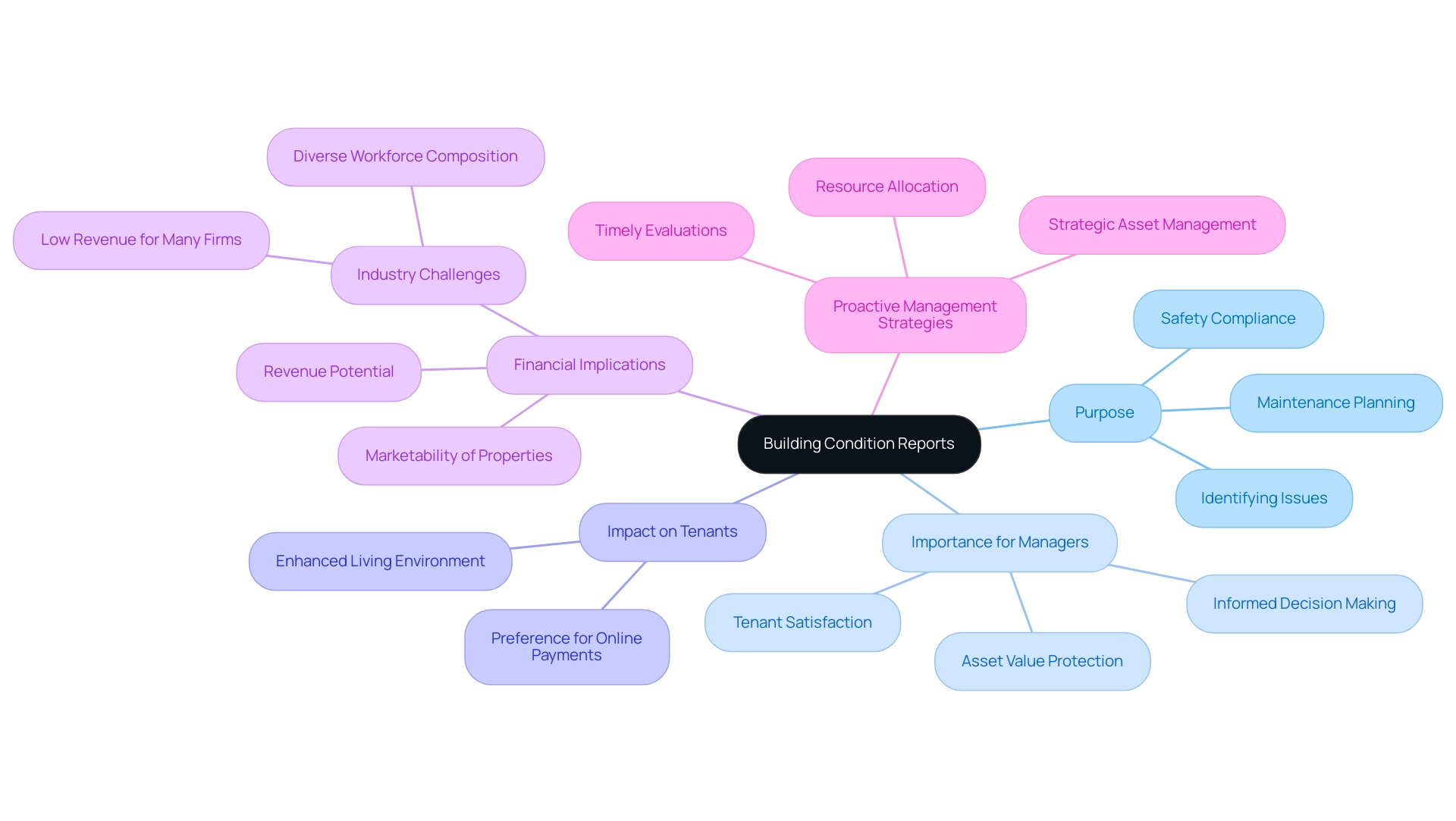
Types of Building Condition Reports: Choosing the Right One for Your Property
Building condition reports serve as vital resources for managers, offering tailored insights relevant to various real estate types and situations. These documents can be categorised into three main levels:
- Level 1 Condition Summary: This document provides a fundamental overview, making it suitable for new or nearly new real estate. It focuses on identifying major flaws without delving into detailed evaluations, making it a cost-effective choice for preliminary assessments.
- Level 2 Homebuyer’s Survey: More comprehensive than a Level 1 analysis, the Level 2 survey identifies potential issues and offers recommendations for further inquiry. This document is particularly beneficial for prospective buyers who need to grasp the asset’s condition before making a purchasing decision.
- Level 3 Building Survey: This is the most exhaustive evaluation, ideal for older or complex assets. It thoroughly assesses structural integrity, maintenance needs, and potential risks, providing a complete picture of the asset’s condition. Given ongoing safety concerns, especially regarding issues like unsafe cladding, a Level 3 survey can be crucial for ensuring compliance with current safety standards.
As we look ahead to 2025, the market share for these reports is shifting, with Level 1 reports gaining popularity due to their affordability and simplicity. However, as property managers increasingly recognise the importance of thorough evaluations, the demand for Level 2 and Level 3 surveys is also rising. Recent enforcement actions against structures with unsafe cladding underscore the necessity for detailed evaluations to effectively mitigate risks. As of January 2025, at least 182 improvement notices, 53 hazard awareness notices, and 1 prohibition order have been issued to structures with unsafe cladding, highlighting the urgency of these assessments. Furthermore, the projected cost of rectification for 1,745 structures with life-critical fire safety hazards is approximately £3.7 billion, emphasising the financial implications tied to structure assessments.
When determining the appropriate assessment for a structure, managers should consider the asset’s age, condition, and specific issues. For instance, a Level 1 document may suffice for a newly constructed structure, while an older establishment with a complex history may necessitate a Level 3 survey to uncover hidden problems. Understanding these distinctions is crucial for making informed decisions that align with the building condition report, regulatory requirements, and safety standards.
The implications of the energy transition and safety are paramount in the context of structure evaluations, further underscoring the necessity for thorough assessments.
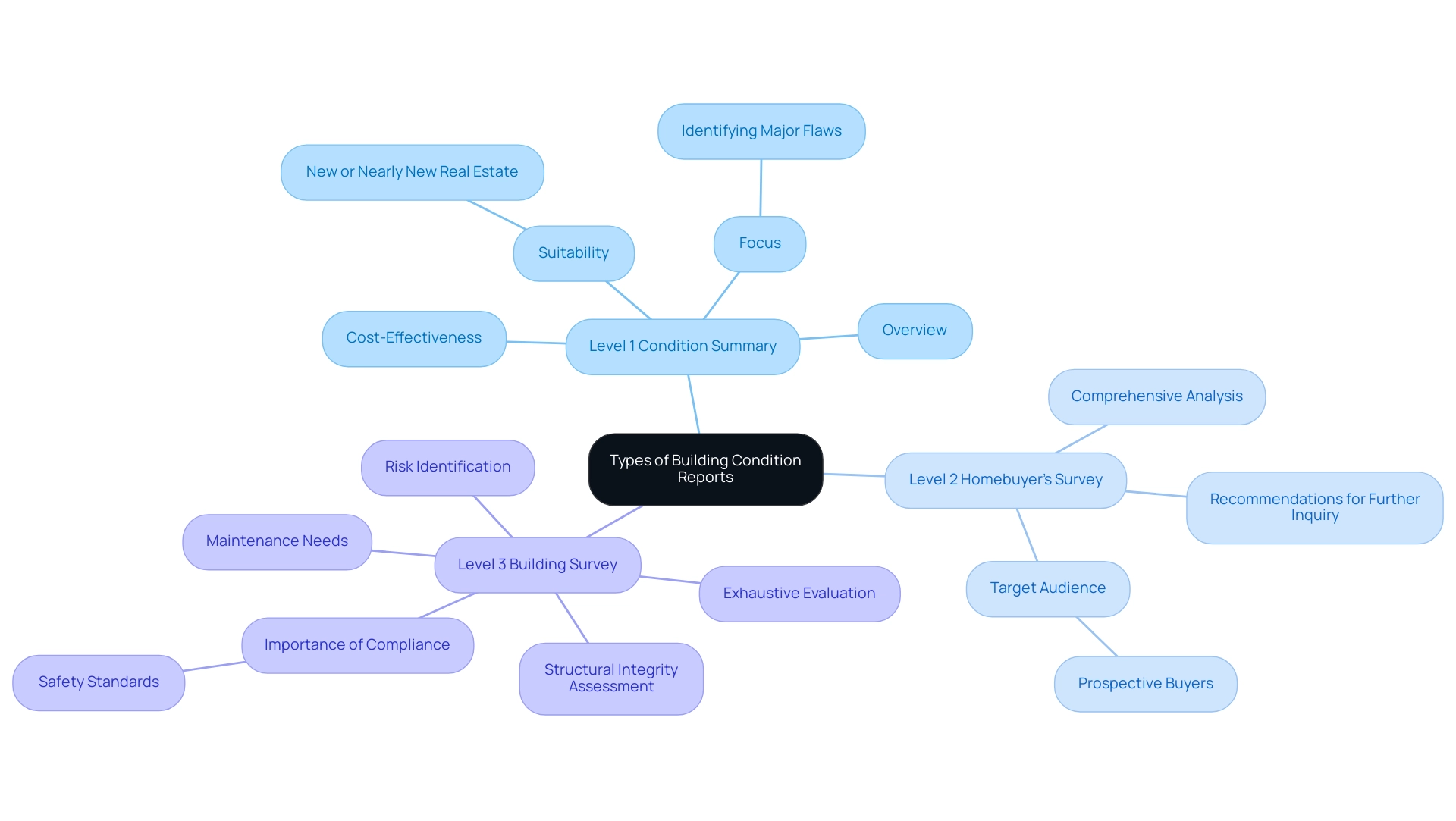
The Building Condition Report Process: What to Expect
Conducting a building condition report necessitates a systematic approach that guarantees a thorough evaluation and documentation of the structure’s state. This process typically unfolds in several key steps:
- Initial Consultation: This step involves a discussion between the manager and the surveyor to review the site’s history and address any specific concerns. This dialogue is crucial for customising the inspection to the unique requirements of the site, aligning with Edmond Shipway’s commitment to providing tailored construction consultancy services.
- Site Inspection: The surveyor performs a comprehensive visual inspection of the property, focusing on critical structural elements, systems, and finishes. This phase is essential for identifying visible defects and potential issues that may require further investigation, ensuring that safety and compliance are prioritised in line with Edmond Shipway’s focus on project management and cost efficiency.
- Data Collection: During this stage, the surveyor gathers detailed information regarding the condition of various components, including roofs, walls, and mechanical systems. This data is vital for assessing the overall health of the building and identifying areas that may need remediation, reflecting the thoroughness that Edmond Shipway brings to its consultancy services.
- Report Compilation: The findings from the inspection and data collection are assembled into a detailed document. This document serves as a building condition report that highlights identified issues, offers recommendations for repairs or maintenance, and acts as a valuable resource for managers in decision-making, showcasing Edmond Shipway’s expertise in delivering actionable insights.
- Review and Discussion: Ultimately, the document is examined with the manager to discuss the findings and outline the next steps. This collaborative discussion ensures that all parties are aligned on the necessary actions moving forward, reinforcing the importance of communication in Edmond Shipway’s approach to project management.
Property managers can expect a clear timeline and consistent communication throughout the process, which is essential for effective project management. In 2025, the average duration required to perform condition assessments in the UK is roughly four to six weeks, depending on the size and complexity of the structure. Furthermore, recent statistics indicate that 1,700 structures require life-critical fire safety remediation, with 419 (25%) having completed the necessary work.
Significantly, 441 structures (30% of those with hazardous cladding) have finished remediation, highlighting the necessity of comprehensive inspections and prompt reporting in upholding safety and compliance in management. Furthermore, the Construction Sector Deal highlights the government’s dedication to enhancing training and recruitment within the construction industry, further contextualising the significance of adherence and safety in the construction assessment process.
Successful site evaluations and documentation not only enhance safety but also add to the overall worth and durability of the asset, aligning with Edmond Shipway’s mission to provide sustainable and efficient construction consultancy solutions.

Key Components of a Building Condition Report: What to Look For
A comprehensive building condition report is essential for effective property management and typically encompasses several key components:
- Executive Summary: This section provides a succinct overview of the property’s overall condition, highlighting major findings and areas of concern. It serves as a quick reference for stakeholders to understand the asset’s status at a glance.
- Condition Ratings: Utilising a rating system, often colour-coded, this component indicates the severity of issues identified during the assessment. Such ratings help prioritise maintenance efforts and allocate resources effectively.
- Detailed Observations: This part includes specific notes on various structural elements, mechanical systems, and any defects observed. Thorough observations are essential for grasping the subtleties of the asset’s state and for organising required interventions.
- Photographic Evidence: Alongside the written observations, photographic documentation offers visual proof of the state of the asset. This evidence is invaluable for illustrating issues and supporting recommendations.
- Recommendations: Based on the findings, this section outlines suggested actions for repairs or further assessments. Recommendations assist managers in creating maintenance strategies that tackle immediate concerns and prepare for long-term sustainability.
As the construction sector adjusts to changing market trends in 2025, managers must emphasise these elements in their facility assessment reports. Notably, statistics indicate that issues are frequently found in 75% of building condition reports, underscoring the importance of thorough evaluations. Moreover, the output in the production of concrete, cement, and other items for construction rose by 12.0% from December 2023 to December 2024, reflecting current market dynamics that real estate managers must navigate.
Insights from industry experts highlight the importance of comprehending findings to make informed choices that align with current sustainability standards and technological advancements. Building evaluations are essential in ensuring that assets not only meet current standards but are also ready for future challenges.
Furthermore, the case study titled ‘Government Investment Impact on Construction’ demonstrates how macroeconomic factors and policy changes are affecting the construction sector, emphasising the importance of comprehensive building condition reports. With Ireland being the largest export market for UK construction materials in 2024, accounting for 18.3% of total exports, real estate managers should also consider broader market trends that may impact their strategies. By concentrating on rating assessments and practical suggestions, managers can improve their maintenance strategies and guarantee the durability of their assets.
Edmond Shipway is dedicated to offering extensive construction advisory services that enhance efficient asset management through thorough structure evaluations.
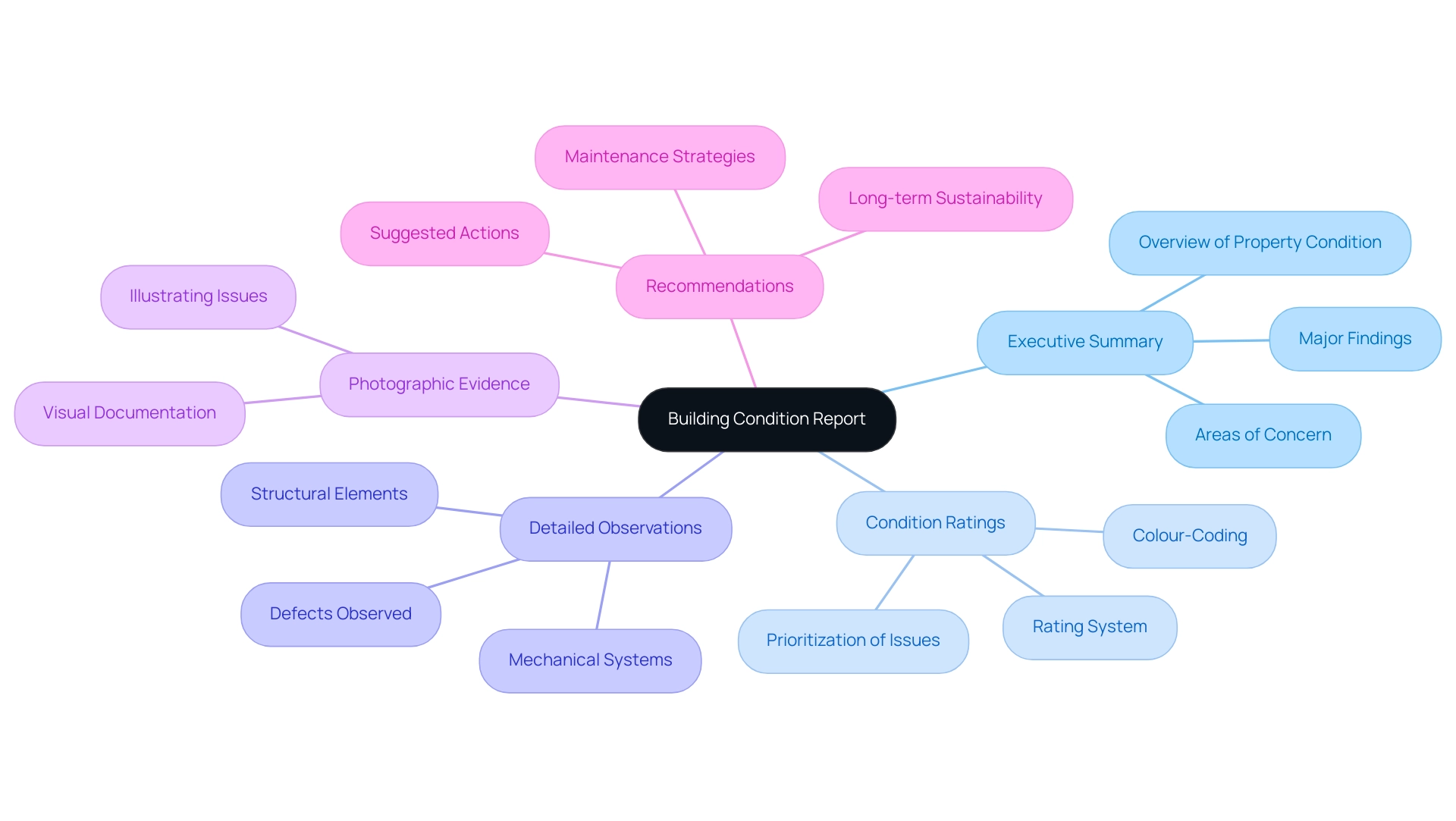
Identifying Common Issues: What Building Condition Reports Reveal
Building condition reports frequently reveal a range of prevalent issues that can significantly affect management and property value. Among these, damp and moisture problems are particularly alarming. Signs of water ingress or insufficient drainage can result in severe structural damage if not swiftly addressed.
Recent statistics reveal that 439 out of 1,745 structures identified with life-critical fire safety risks have undergone remediation, highlighting the critical need for timely intervention in maintenance.
Another prevalent issue is structural cracks, which may indicate movement or settling within the building. These cracks require further investigation to ascertain their cause and potential implications for structural integrity. Moreover, electrical and plumbing issues often emerge in older buildings, where outdated or faulty systems can pose considerable safety risks, making it imperative for managers to prioritise these assessments.
Roofing deficiencies, such as missing shingles or leaks, can lead to interior damage and escalate repair costs if not addressed promptly. The ramifications of damp and moisture issues extend beyond immediate structural concerns; they can also diminish value over time. Expert insights indicate that properties with unresolved damp issues may experience a decline in market appeal, underscoring the necessity of thorough building condition reports for preserving asset value.
Real-world examples underscore the significance of these reports. In the aftermath of the Grenfell Tower disaster, the UK construction sector has encountered evolving safety regulations, resulting in heightened scrutiny on compliance. The engineering and construction sector continues to benefit from government investment, stressing the importance of addressing structural issues.
This regulatory shift accentuates the need for proactive measures in identifying and addressing common problems outlined in building condition report documents. By recognising these challenges early, property managers can implement effective strategies to mitigate risks, ensuring the longevity and value of their properties.
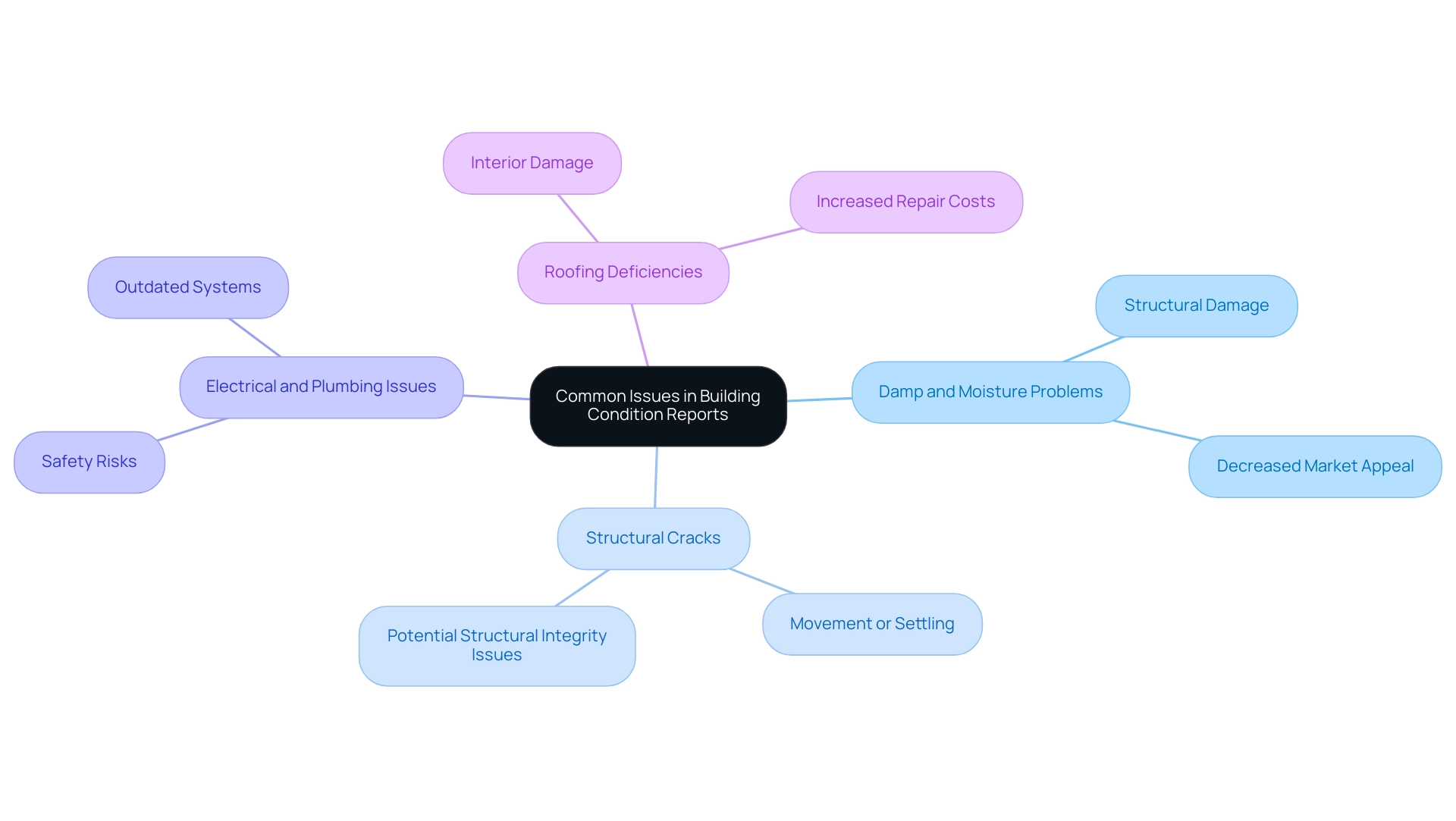
The Importance of Hiring Qualified Professionals for Building Condition Reports
Engaging qualified professionals for building condition reports is crucial for several compelling reasons:
- Expertise: Trained professionals bring a wealth of knowledge and experience, enabling them to detect issues that may elude the untrained eye. Their ability to evaluate the state of a structure comprehensively ensures that potential problems are identified early, which can save significant costs in the long run. Edmond Shipway’s Mechanical and Electrical Consultants specialise in construction services, focusing on energy efficiency and reducing CO2 emissions, essential for sustainable development.
- Compliance: Qualified surveyors are well-versed in the latest industry standards and legal requirements. Their evaluations not only comply with these regulations but also assist managers in avoiding expensive compliance problems that could result from insufficient reporting. Recent findings from the Regulator of Social Housing regarding fire safety in structures over 11 metres underscore the urgency of obtaining precise and compliant building condition reports.
- Credibility: Reports generated by recognised professionals carry substantial weight in negotiations and legal contexts. Their expertise lends credibility to the findings, making it easier for managers to advocate for necessary repairs or improvements. Client testimonials from satisfied customers, highlight Edmond Shipway’s commitment to delivering first-class service and innovative solutions, reinforcing the value of their consultancy.
Investing in qualified experts for facility condition evaluations ultimately improves decision-making and risk management for asset managers. For instance, a recent survey indicated that 88% of global real estate executives anticipate revenue increases, underscoring the importance of sound investment decisions supported by thorough assessments. Furthermore, case studies reveal that organisations aligning with the values of younger generations, such as sustainability and mental health, are more successful in attracting talent, which is essential for maintaining a skilled workforce in the construction sector.
In 2025, the focus on employing qualified professionals is more relevant than ever, particularly considering recent findings from the Regulator of Social Housing concerning fire safety in structures over 11 metres. These insights highlight the pressing need for accurate and compliant building condition reports to ensure safety and adherence to regulations. By prioritising professional evaluations, managers can navigate the complexities of compliance and enhance the overall value of their assets.
Additionally, the optimism reflected in the “Commercial Real Estate Recovery Outlook” case study suggests that increased investment in professional assessments could be a key strategy for recovery in the sector. By addressing the workforce gap and aligning with the values of younger generations, managers can ensure they are well-equipped to meet the challenges of the evolving real estate landscape.
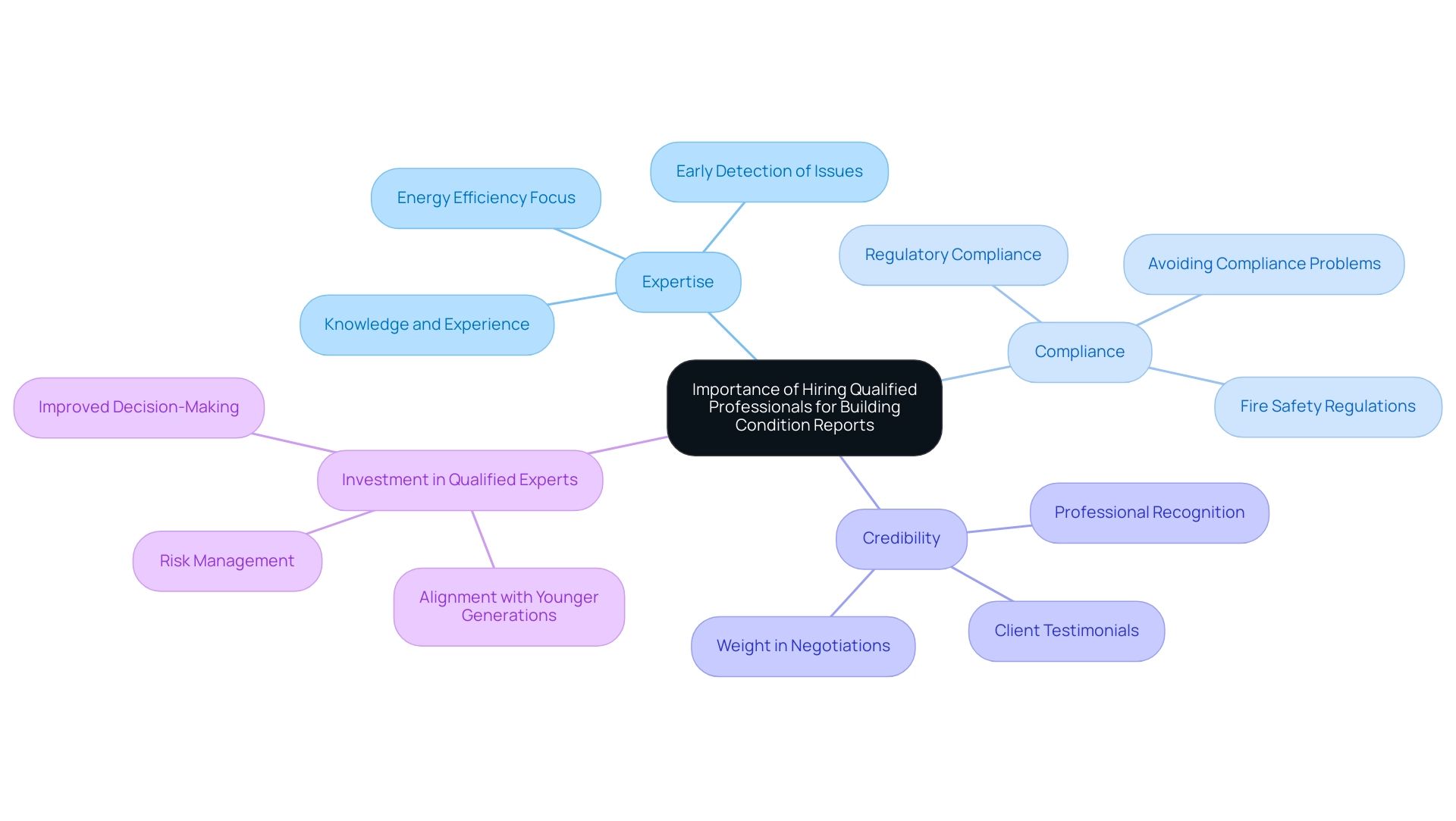
Interpreting Building Condition Report Findings: Making Informed Decisions
Interpreting the findings of a building condition report is paramount for property managers who seek to maintain and enhance property value while ensuring tenant satisfaction. To navigate this process effectively, consider the following key steps:
- Understanding Condition Ratings: Start by familiarising yourself with the rating system utilised in the report. This system typically categorises issues based on severity, enabling you to quickly assess which problems are critical and which are less urgent. A clear understanding of these ratings is essential for prioritising actions effectively.
- Prioritising Repairs: Leverage the recommendations provided in the building condition report to pinpoint issues that require immediate attention. Structural concerns or safety hazards should be addressed promptly, while cosmetic repairs can often be scheduled for a later date. This prioritisation not only ensures compliance with safety standards but also optimises resource allocation.
- Budgeting for Repairs: Evaluate the financial implications of the findings to plan your budget accordingly. Understanding the costs associated with each identified issue will help you allocate funds effectively and avoid unexpected expenses. This proactive approach is particularly significant, underscoring the necessity for well-maintained facilities that enhance tenant appeal. By ensuring that assets are in peak condition, managers can create environments that attract and retain renters.
By mastering the analysis of building condition reports, property managers can make informed choices that not only enhance property value but also significantly improve tenant satisfaction. Real-world examples illustrate that prioritising repairs based on the building condition report leads to better management outcomes and fosters a positive living environment for tenants.
As the commercial real estate sector anticipates a resurgence in 2025, effective management of property conditions will be crucial in attracting and retaining tenants, particularly as organisations adapt to the shifting workforce environment. Furthermore, incorporating management information tables that provide detailed data on remediation progress and enforcement actions can enhance clarity and accountability in asset management.
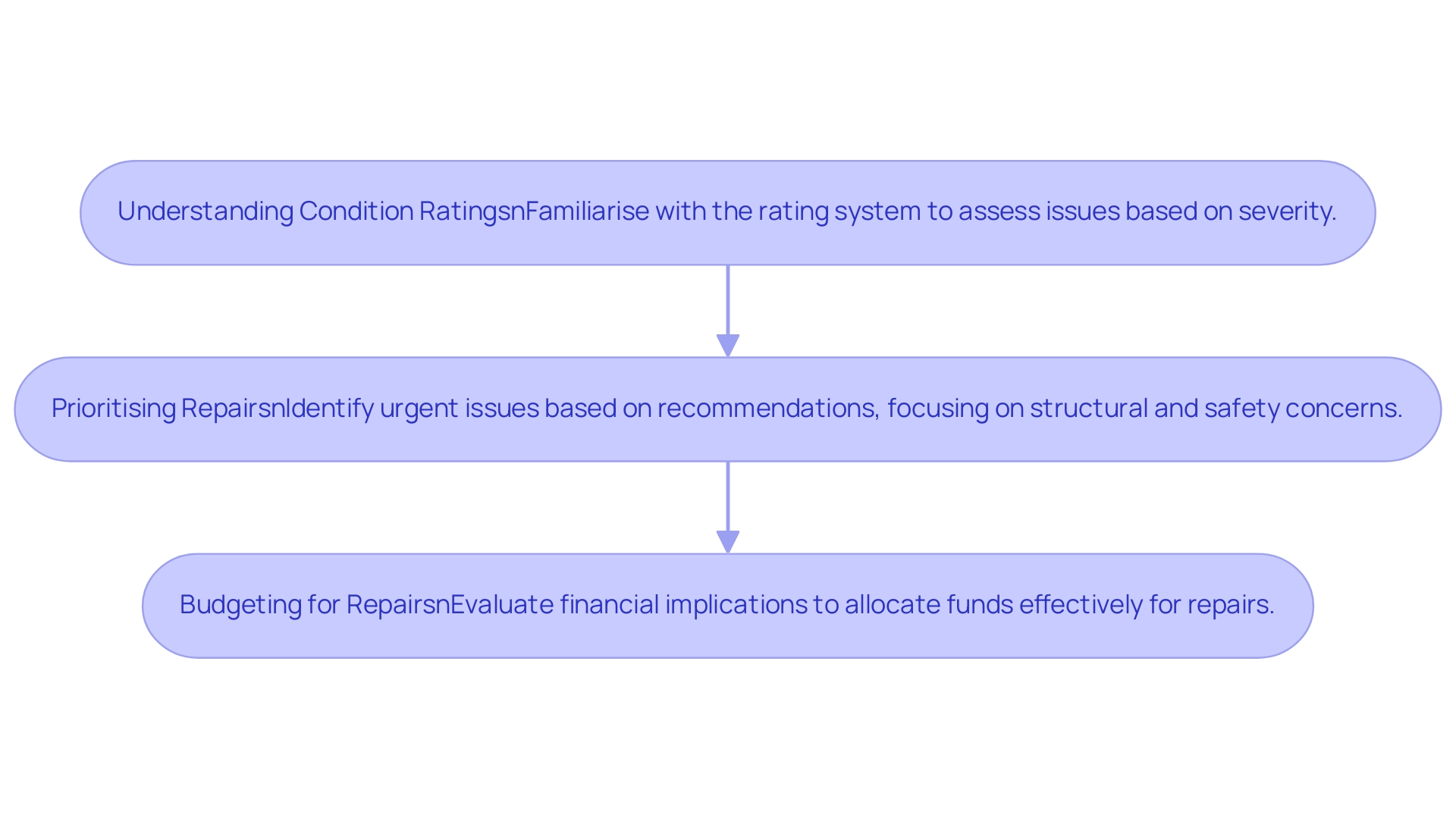
Taking Action: Next Steps After Receiving a Building Condition Report
Upon receiving a building condition report, property managers must undertake critical steps to ensure effective property management and maintenance.
- Thoroughly Review the Report: Begin by carefully examining all findings and recommendations outlined in the report. Understanding the nuances of the assessment is crucial for informed decision-making.
- Prioritise Repairs: Assess the identified issues to determine which require immediate action and which can be scheduled for future attention. This prioritisation is essential for effective resource allocation and risk management.
- Develop a Comprehensive Maintenance Plan: Formulate a detailed timeline for addressing the identified issues, integrating budget considerations and resource availability. A well-organised maintenance plan not only enables timely repairs but also improves the lifespan of the asset.
Given that only 13% of management firms earn over £1 million in annual revenue, effective maintenance planning is crucial for enhancing asset value and management success.
- Communicate with Stakeholders: Keep all relevant parties, including landowners and tenants, informed about the findings and the planned course of action. Transparent communication fosters trust and ensures that everyone is aligned with the maintenance strategy.
- Monitor Progress Regularly: Establish a system for tracking the status of repairs and maintenance activities. Regular monitoring helps ensure that tasks are completed on schedule and allows for adjustments as necessary. By implementing these steps, managers can significantly enhance the value and functionality of their assets.
Statistics indicate that proactive management strategies lead to improved outcomes; for instance, 64% of buildings applying for funding in the Building Safety Fund have initiated or completed remediation efforts. This underscores the importance of taking decisive action following a building condition report to ensure safety and compliance.
Additionally, the emphasis on accelerated upskilling and reskilling initiatives highlights the need for property managers to stay informed and proactive in their strategies, ensuring continuous improvement in their management practices.
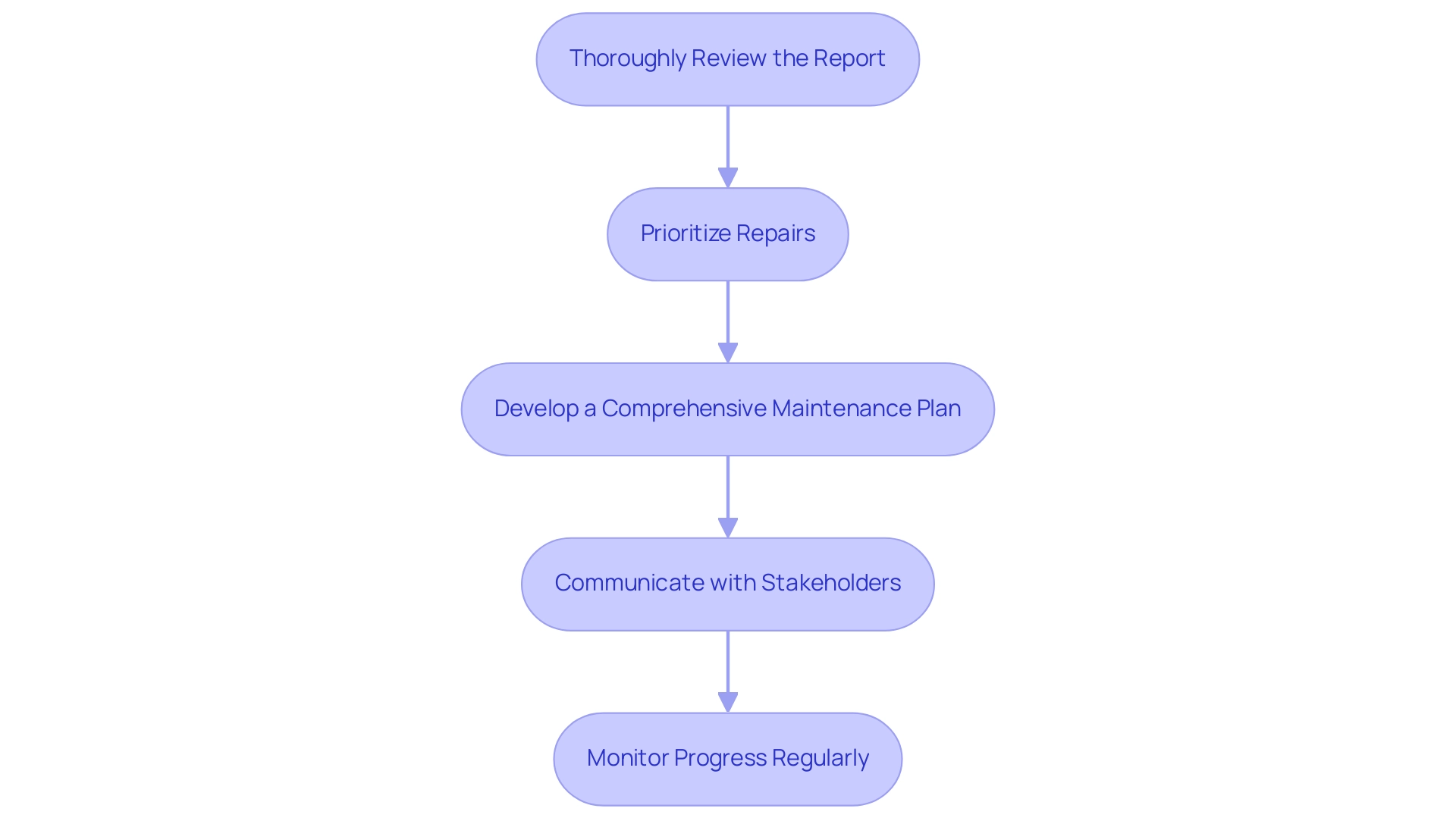
Conclusion
Building condition reports are indispensable for effective property management, serving as a comprehensive tool to assess a property’s current state. They not only identify existing issues but also guide maintenance planning and ensure compliance with safety regulations. The increasing emphasis on safety and tenant satisfaction underscores the necessity for property managers to engage in thorough assessments to maintain property value and appeal.
Understanding the different types of building condition reports, ranging from basic overview assessments to detailed surveys, is crucial in selecting the right evaluation for specific properties. The systematic process of conducting these reports, from initial consultations to detailed inspections and report compilations, ensures that property managers receive actionable insights that inform their decision-making.
Interpreting the findings of a building condition report is critical for prioritising repairs and managing budgets effectively. By focusing on urgent issues, property managers can enhance tenant satisfaction and ensure compliance with safety standards. Moreover, engaging qualified professionals for these assessments adds credibility and expertise, which is vital in navigating the complexities of property management.
Ultimately, taking decisive action following a building condition report, including developing comprehensive maintenance plans and maintaining open communication with stakeholders, is essential for enhancing property value and functionality. As the landscape of property management continues to evolve, the importance of building condition reports remains a cornerstone for successful and sustainable property management practices.
Share


